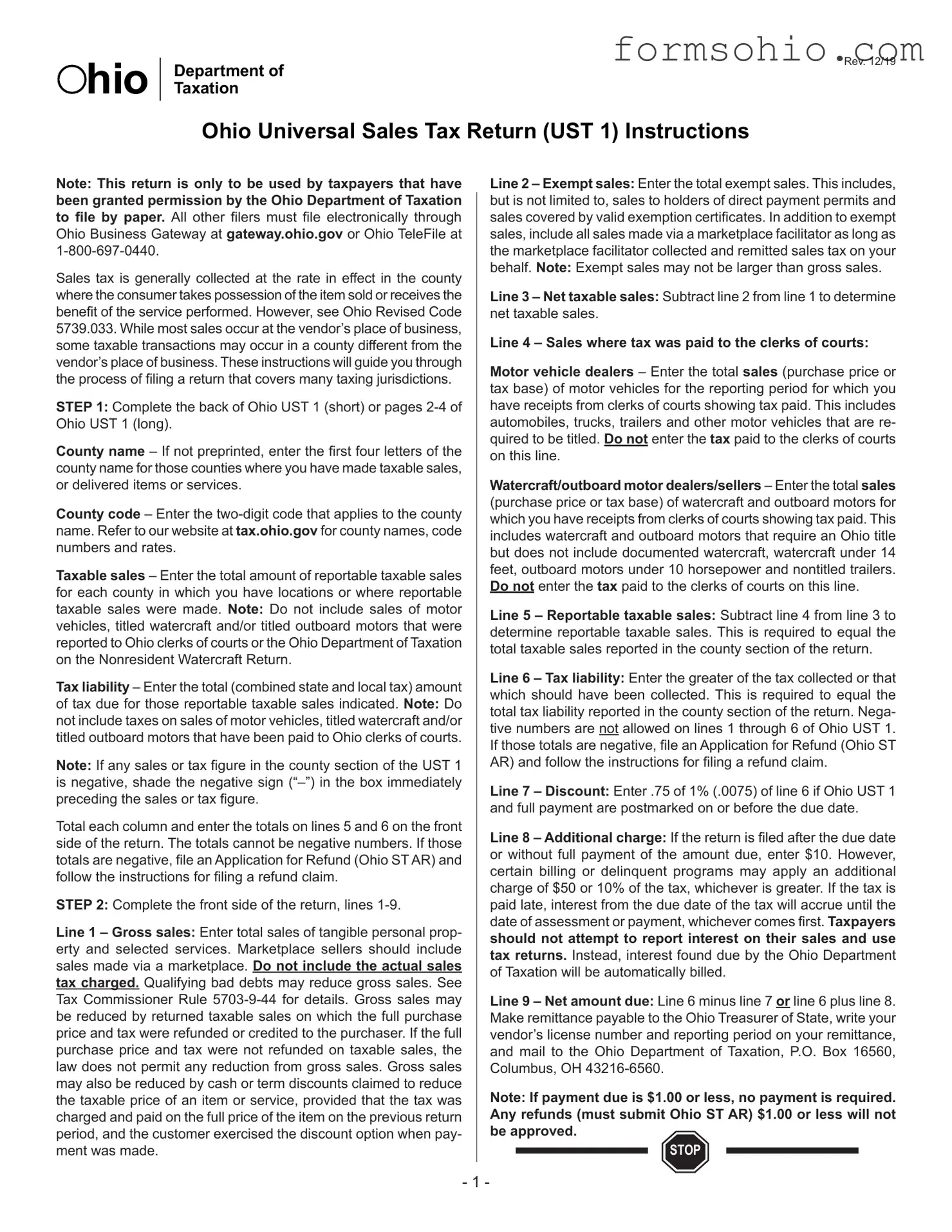Note: This return is only to be used by taxpayers that have
been granted permission by the Ohio Department of Taxation to file by paper. All other filers must file electronically through Ohio Business Gateway at gateway.ohio.gov or Ohio TeleFile at
1-800-697-0440.
Sales tax is generally collected at the rate in effect in the county where the consumer takes possession of the item sold or receives the benefit of the service performed. However, see Ohio Revised Code 5739.033. While most sales occur at the vendor’s place of business, some taxable transactions may occur in a county different from the vendor’s place of business. These instructions will guide you through the process of filing a return that covers many taxing jurisdictions.
STEP 1: Complete the back of Ohio UST 1 (short) or pages 2-4 of Ohio UST 1 (long).
County name – If not preprinted, enter the first four letters of the county name for those counties where you have made taxable sales, or delivered items or services.
County code – Enter the two-digit code that applies to the county name. Refer to our website at tax.ohio.gov for county names, code numbers and rates.
Taxable sales – Enter the total amount of reportable taxable sales for each county in which you have locations or where reportable taxable sales were made. Note: Do not include sales of motor vehicles, titled watercraft and/or titled outboard motors that were reported to Ohio clerks of courts or the Ohio Department of Taxation on the Nonresident Watercraft Return.
Tax liability – Enter the total (combined state and local tax) amount of tax due for those reportable taxable sales indicated. Note: DO not include taxes on sales of motor vehicles, titled watercraft and/or titled outboard motors that have been paid to Ohio clerks of courts.
Note: If any sales or tax figure in the county section of the UST 1 is negative, shade the negative sign (“–”) in the box immediately preceding the sales or tax figure.
Total each column and enter the totals on lines 5 and 6 on the front side of the return. The totals cannot be negative numbers. If those totals are negative, file an Application for Refund (Ohio ST AR) and follow the instructions for filing a refund claim.
STEP 2: Complete the front side of the return, lines 1-9.
Line 1 – Gross sales: Enter total sales of tangible personal prop- erty and selected services. Marketplace sellers should include sales made via a marketplace. Do not include the actual sales tax charged. Qualifying bad debts may reduce gross sales. See Tax Commissioner Rule 5703-9-44 for details. Gross sales may be reduced by returned taxable sales on which the full purchase price and tax were refunded or credited to the purchaser. If the full purchase price and tax were not refunded on taxable sales, the law does not permit any reduction from gross sales. Gross sales may also be reduced by cash or term discounts claimed to reduce the taxable price of an item or service, provided that the tax was charged and paid on the full price of the item on the previous return period, and the customer exercised the discount option when pay- ment was made.
Line 2 – Exempt sales: Enter the total exempt sales. This includes, but is not limited to, sales to holders of direct payment permits and sales covered by valid exemption certificates. In addition to exempt sales, include all sales made via a marketplace facilitator as long as the marketplace facilitator collected and remitted sales tax on your behalf. Note: Exempt sales may not be larger than gross sales.
Line 3 – Net taxable sales: Subtract line 2 from line 1 to determine net taxable sales.
Line 4 – Sales where tax was paid to the clerks of courts:
Motor vehicle dealers – Enter the total sales (purchase price or tax base) of motor vehicles for the reporting period for which you have receipts from clerks of courts showing tax paid. This includes automobiles, trucks, trailers and other motor vehicles that are re- quired to be titled. Do not enter the tax paid to the clerks of courts on this line.
Watercraft/outboard motor dealers/sellers – Enter the total sales (purchase price or tax base) of watercraft and outboard motors for which you have receipts from clerks of courts showing tax paid. This includes watercraft and outboard motors that require an Ohio title but does not include documented watercraft, watercraft under 14 feet, outboard motors under 10 horsepower and nontitled trailers. Do not enter the tax paid to the clerks of courts on this line.
Line 5 – Reportable taxable sales: Subtract line 4 from line 3 to determine reportable taxable sales. This is required to equal the total taxable sales reported in the county section of the return.
Line 6 – Tax liability: Enter the greater of the tax collected or that which should have been collected. This is required to equal the total tax liability reported in the county section of the return. Nega- tive numbers are not allowed on lines 1 through 6 of Ohio UST 1. If those totals are negative, file an Application for Refund (Ohio ST AR) and follow the instructions for filing a refund claim.
Line 7 – Discount: Enter .75 of 1% (.0075) of line 6 if Ohio UST 1 and full payment are postmarked on or before the due date.
Line 8 – Additional charge: If the return is filed after the due date or without full payment of the amount due, enter $10. However, certain billing or delinquent programs may apply an additional charge of $50 or 10% of the tax, whichever is greater. If the tax is paid late, interest from the due date of the tax will accrue until the date of assessment or payment, whichever comes first. Taxpayers
should not attempt to report interest on their sales and use tax returns. Instead, interest found due by the Ohio Department of Taxation will be automatically billed.
Line 9 – Net amount due: Line 6 minus line 7 or line 6 plus line 8. Make remittance payable to the Ohio Treasurer of State, write your vendor’s license number and reporting period on your remittance, and mail to the Ohio Department of Taxation, P.O. Box 16560, Columbus, OH 43216-6560.
Note: If payment due is $1.00 or less, no payment is required. Any refunds (must submit Ohio ST AR) $1.00 or less will not be approved.
STOP


 hio
hio